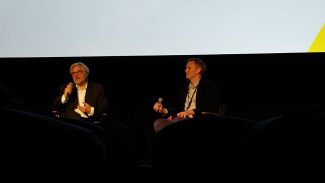The Red Turtle ( Michael Dudok de Wit, 2016): Japan | France | Belgium
Reviewed by Katrina Storton. Viewed at AFI Film Festival 2016.

The Red Turtle (2016) is a new Studio Ghibli produced film (Studio Ghibli has produced films like Ponyo, Spirted Away, Howl’s Moving Castle and more) and the first Studio Ghibli film directed by a non-Japanese director. Director Michael Dudok de Wit is a Dutch animator, director and illustrator. The Red Turtle (2016) is Michael’s first feature film. His filmography consists of various short films such as The Monk and the Fish (1994) and Father and Daughter (2000). During the Q&A Michael Dudok de Wit spoke of his The Red Turtle and how the collaboration between him and Studio Ghibli came about.
It was Michael’s animated short films that caught Hayao Miyazaki’s (One of the founders and most know directors of Studio Ghibli) attention. Particularly Father and Daughter, in which Miyazaki told Michael that he felt the film was a Japanese film. Miyazaki proposed to him an offer to make a full feature film fully funded by Studio Ghibli and Michael immediately accepted.

Michael Dudok de Wit during the Q&A.
What is special about Michael Dudok de Wit’s animation that caught Miyazaki’s eye is the individual and unique art style of his shorts, their similar Japanese animation qualities and the power they hold without the use of dialog.
No dialog was the strongest factor is The Red Turtle. The film focuses on a man lost at sea, caught in a storm. He washes up on a deserted island, he makes friends with the island crabs and takes a while to get to know the land. Once it is clear there is nothing on the island for him he builds a raft to venture back out on the sea. Once out of the shallow waters, all looks well. He has a well-built bamboo raft, plenty of food and calm waters. This is until a mysterious force destroys the raft into pieces forcing the man to swim back to shore. This experience happens over and over. The man builds a raft better than the last but once at a certain point in the water the raft is mysteriously attacked from the water underneath. After around the 3rd or 4th attempt, the mystery is solved, it is a giant red turtle and his intent is to keep the man from leaving by destroying his raft. The man is enraged by this and begins to show ill-intentioned actions towards the turtle not realizing the turtle will provide for him all he needs in life.
The Red Turtle look 8 years to perfect but is incredibly powerful for not uttering a word of dialog. The lack of dialog causes extra attention to be given to the tiniest of details. The day time is bright and vibrant, the night scenes are grey toned yet tranquil and the dream sequences are colorful with an overlay of shimmer and gleam. The animation is transcendent. The ocean waves are mesmerizing to watch, the colors are awe-inspiring and the art style simplistically beautiful. The look of The Red Turtle doesn’t match other Studio Ghibli films but it still possesses the spirit and emotions of a Studio Ghibli film. The musical score is another element that adds to the emotion and translation of the film’s compelling plot. Only one score in the film used a real human female voice, the rest was solely instrumental. Michael Dudok de Wit was hesitant to use a human voice in his film as he felt it would separate the audience from the emotions of the scene if they heard anything that sounded like a voice. However, the female voice chosen was perfect and sounded like an instrument, never taking away from the scene but instead adding to it. I personally didn’t even notice the voice until Michael mentioned it during the Q&A. Obviously since I didn’t even notice it was a voice, Michael had nothing to worry about. His story and animation was too enthralling to be removed from so easily.
This film is a must for any animation fan or Studio Ghibli fan. The Red Turtle can be understood by anyone no matter their language or background. Its simple plot of a man lost at sea wash up on an island is basic and able to be understood no matter the culture or language of the viewer. The film is without a doubt a phenomenal work of art that conveys themes of hardship, family, survival, trust, nature, aging, life and forgiveness. It will grip you, it will tear you, it will make you cry and make you smile, all without a word. The Red Turtle is a film to behold and it has certainly earned its place amongst all other Studio Ghibli classics.
About this entry
You’re currently reading “The Red Turtle ( Michael Dudok de Wit, 2016): Japan | France | Belgium,” an entry on Student Film Reviews
- Published:
- 11.22.16 / 5am
- Category:
- AFI Filmfest 2016, Animation, Films
2 Comments
Jump to comment form | comments rss [?]